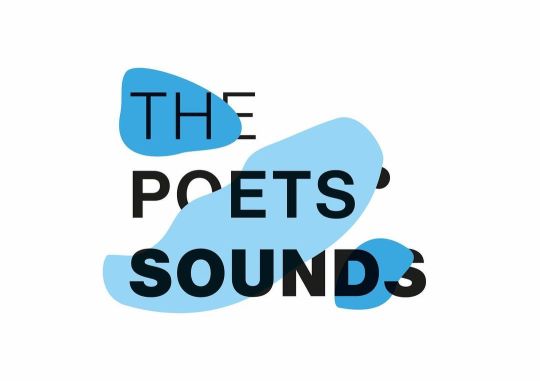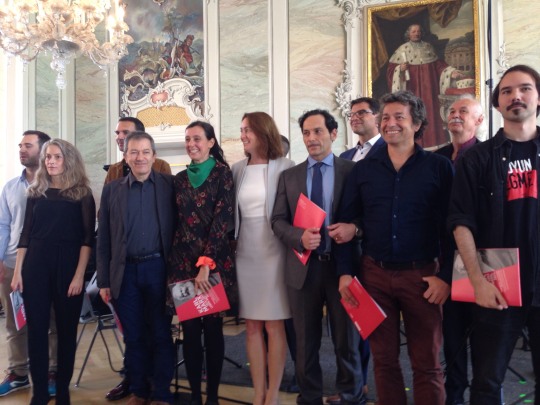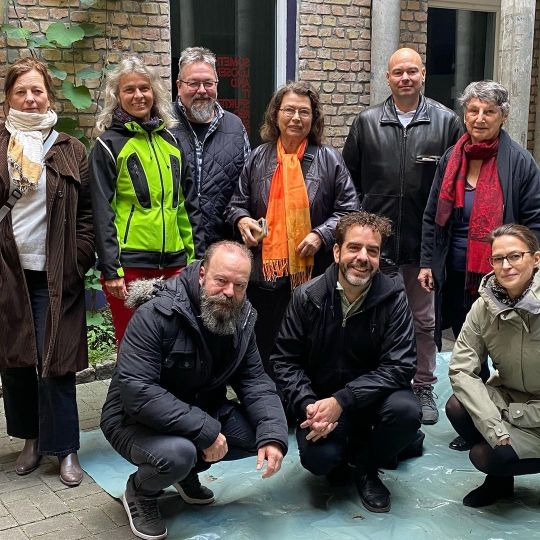#sprachmusik
Photo

Der Countdown läuft. 11. Juni, 19.00, Collegium Hungaricum Berlin, Dorotheenstraße 12 und 12. Juni, 20.00, Loft Köln, Wißmannstraße 30. Kommt und hört‘s Euch an; es wird toll! #sprachmusik #musikundsprache #musicandspeech #sprechbohrer #lettretage #mortensøndergaard #miiatoivio #katalinladik #eduardescoffet #toneavenstroup #elisabethwandelerdeck #sigridsachse #haraldmuenz #georgsachse https://www.instagram.com/p/CemeHiiIoy_/?igshid=NGJjMDIxMWI=
#sprachmusik#musikundsprache#musicandspeech#sprechbohrer#lettretage#mortensøndergaard#miiatoivio#katalinladik#eduardescoffet#toneavenstroup#elisabethwandelerdeck#sigridsachse#haraldmuenz#georgsachse
0 notes
Text
Marx Music
The BCMG opened their programme this year with a series of concerts in Birmingham and Trier celebrating the 200th Anniversary of Karl Marx. The music in these concerts comprised large ensemble pieces, duets, and acousmatic/sound art pieces. The ensemble frequently referenced that the programmes were made up of 14 new works which, on reflection, did bear repeating since when I thought of similar projects - on other themes, by other organisations - I most often recalled programmes that were a selection of older works with a few newer pieces. So, as well as to its theme, this project really revealed a commitment towards new work both by supporting it and then by supporting the pieces by performing each on more than once. The BCMG’s programme was made up of a mixture of commissions and works received from an international call for scores leading to prizes awarded in three categories (large ensemble, small ensemble, sound art).
I am not on facebook, and so missed some apparent controversy about whether the BCMG should have chosen this topic or not. Aside from the inflammatory nature of such social media debates, there doesn’t seem to be any question that this could be – and, indeed, was – a fruitful artistic topic. The concerts fitted into a year-long programme of events in Trier that examine Marx’s relationship with his birthplace and the cultural heritage linked to such a relationship; the pieces presented by BCMG reflected a range of topics from the artistic, to the personal, to the political (past and contemporary). The concerts certainly presented the topic as a multi-layered and nuanced one, and also one that was musically fruitful. After the season launch in Birmingham (I wasn’t at that event), three concerts were presented in Trier. I don’t have space here to describe every piece so instead I’m choosing to write particularly about those that particularly appealed to me.
Cecilia Arditto’s music was a real discovery for me over the weekend. Her prize-winning piece, The Dearest Dream, brought together elements of spectralism and feminism through the inclusion of particular objects and gestures that have both a musical and a symbolic meaning. She spoke about the importance of Marx’s ideas in various resistance movements in Argentina, with specific reference to the feminist movement (symbolised by the colour green) and the movement for the separation of church and state (symbolised by the colour orange). In the piece, these ideas could be found in what she describes as an ‘anti-soloist’ part for the percussionist, who performs using various objects including fans, a sweeping brush, a tin can, and a ‘rainstick’ sound using plastic glasses and lentils. Visually, these objects symbolised a ‘poverty’ within the ensemble – for example, she described the four tin cans that are operated by with strings as a ‘string quartet’ – and also various aspects of struggle (after hearing her talk, the orange lentils spoke a lot more clearly, and seeing the percussionist sweeping away also spoke to the theme of the piece). However, beyond this visual symbolism, the work also invited consideration of the project’s themes through its sound, which was often delicate and studied. Beginning from a single note, the music opened to close and then more open harmonies that spoke to admitting many voices; the including of the often quiet and delicate sounds of the objects was carefully managed as an equal role within the ensemble. Where sometimes the use of objects in a composition can seem like a gimmick, the music only had more to offer on a second listening.
I’m clearly already familiar with Alistair Zaldua’s music, but I hope that it is acceptable to say here that I enjoyed the ensemble’s treatment of his piece. The piece manifesto is for 14 instruments and a spoken part which was performed by baritone Marcus Farnsworth. It would me a mistake to think that a part for spoken voice is easier than that for a singer. As well as some rhythmic complexity, and various theatrical modes of delivery, the piece presented the text in ways that were at times in opposition to the ensemble and at times as a single voice within it. I’m aware that it’s commonly assumed that in any music that uses text, the text should always be heard as the most prominent voice, but that wasn’t what was intended here. Alistair spoke about how multiple small variations of the primary fragment of text were used and quasi-repeated throughout the work to present many possible meanings and interpretations of a specific idea from The Communist Manifesto (that the historical conditions need to be right for revolution, and that the working class would need to work together to achieve this), and how this ‘voice’ becomes one of many ‘voices’ within the ensemble who perform a chordal and harmonic material in a way that gains momentum throughout the piece. This working-together was clear in both Trier and Birmingham, even though the sonic relationship between the voice and ensemble differed in different kinds of spaces.
The work of conductor Michael Wendeberg was commendable throughout the project: the music performed was extremely varied and required, in many cases, a lot of physical effort. Nevertheless, his work brought out many of the unique aspects of the individual works, particularly, for example, in Frédéric Pattar’s Deflation - Eine Kleine Marxmusik (a piece whose title doesn’t do it justice) which was extremely quiet and dealt with subtle and distant changes of sound. This music in particular benefitted from the direct environment of the CBSO centre, in which the performance became much more intimate.
Kaspar Querfurth’s Bloßes Zubehör der Maschine – a commission rather than a prize winner - was, for me, the most interesting all of the duet pieces. This piece for baritone and bass flute was tightly-knitted and required a particular ensemble work to bring out its many aspects. In each phrase the flautist performs a variety of techniques in as a fluent musical expression that intertwines with, harmonises, and sometimes contradicts the voice part. Flautist Veronika Klirova offered an excellent performance that was, many times, almost vocal and although we heard Marcus Farnsworth both sing and speak in other works this piece was an opportunity for him to demonstrate his ability in contemporary vocal techniques.
Another of the BCMG commissions, Robert Reid Allan’s work Terry Helens’s Revolutionary Dreams for large ensemble offered a much more theatrical take on the theme. He worked with Gareth Mattey who created a libretto-like text for the piece. On seeing the text in the programme, I wondered how the amount of it would be managed in the duration of the performance and, in fact, the piece was more like an opera scene than an art song. At times other musicians in the ensemble contributed to the delivery of the text which was mostly, impressively, performed by soprano Elizabeth Atherton. Alternation between speaking (as ‘interludes’) and singing (as ‘dreaming’) offered some slightly surreal reflections on the mundanity of day to day life as compared with utopian ideals, and the role of the past, present and future in considering such ideals in the present day. The music itself was quite complex, in that there were multiple layers and senses of time within the progress of the piece, and this was managed well by both the composer and the musicians who maintained the sense of drama and strangeness.
These two commission pieces showed good consideration of handling the text and timing – which was not the case throughout the concerts. It will continue to amaze that some composers have seemingly no sense of time, or else simply disregard the duration of their pieces. This has a clear knock-on effect to the work of musicians and the time taken over the presentation of not only their own but all of the music – something that resonates with the theme behind Celeste Oram’s work presented in this series. The venues were perhaps not considered ideal for all of the music, and Celeste Oram’s piece Pierrot Laborieux, for example, did not fare as well since its electronic elements weren’t communicated as clearly as she probably would have liked. That performance, however, is derived from an installation titled work & The Work that examines the real conditions of musicians’ working lives in contrast to, and as a part of, the creation of musical ‘works’. That installation was in Trier although I didn’t get to it; it will now be at the V&A in London. Its description is particularly interesting to me, so I hope to get to it and experience her ideas more directly that I did during the concert.
Of the sound art works, the piece by Aldo Brizzi presented a clear and audible relationship to Marx through its intermedial relationship to Luigi Nono in its construction and sonic materials. The music of this work was sensitively constructed both in the nature of the sound and the music’s structure. A further piece by Christophe Lambert engaged my interest in Sprachmusik, presenting text in English, French, German and Spanish. The text was a quote from Marx, reflecting on the length of the working day. Stephan Fricke, who introduced the piece in Trier, made the point that although working conditions in Western Europe are much improved from those described by Marx, in other places in the world the same or worse conditions are still being experienced. The music presented individual speaker voices, and the use of different languages presented how such information can be both ‘familiar’ and ‘other’, as well as how something that seems ‘neutral’ (such as speaking numbers) becomes ‘political’ in the context of voicing something such as the length of the working day. These materials were sparsely and sensitively handled.
It was unfortunate that a misunderstanding between the organisers and the gallery meant that the sound art works presented on the Saturday night were affected by a lack of equipment. The three pieces were heard in a mono format which left me wondering about aspects of the music (such as space) that were not rendered so well. These works will be broadcast on German radio and re-presented at a concert at The Dome at the University of Birmingham on 29th September. At that concert, they’ll experience the treatment from the mini-Beast system – probably about as far away from a mono performance as you can get – and so I think this opportunity to hear these works will be worth it for anyone who can make it.
The project offered the opportunity for an interesting comparison between the spaces in Trier (historical buildings, shiny surfaces!) and the CBSO centre (modern building, acoustically treated). The latter is certainly an excellent space for contemporary music, as the sound is very direct. This room, therefore, brought out for me aspects of the music that weren’t so clear in the performances in Trier. But the spaces in Trier were also able to offer something different to some of the pieces, too, and created an immersive atmosphere in the concerts even when the music could have been seen to be out-of-place in its slightly imperial surroundings. Overall, this has been an interesting and fruitful musical experience for me; one that was brought to life by informed and engaged musicians, and I was very glad to hear many of the pieces more than once. Radio broadcasts (on German radio) are planned so there will likely be future opportunities to hear this music.

0 notes
Text
Blogparade: Gesellschaftskritische Songtexte, die dich zu einem besseren Menschen machen
Selbstanalyse (Pt. 21)
Das Blog "Pflücke den Tag" wird unter einem Decknamen geführt, der da heißt: Miss O'Laugh. Bereits am 28. Juni bestätigte ich meine Teilnahme an Ihrer Blogparade, allerdings mit dem Hinweis, dass ich erst im Juli dazu kommen werde. Und so war es auch, nur zum Schreiben eines Blogposts kam ich im abgelaufenen Kalendermonat nicht. Tatsächlich fühle ich mich bei der Niederschrift meiner (Bilder-)Gedankensammlung diesen just ausgesetzt, waren sie doch nicht tiefgreifend genug. Ich werde aber trotzdem mein querdenkerisches Sein spontan dazu nutzen, um einen anständigen Beitrag abzuliefern, wenn auch mit Verspätung.
Vorweg: Die Blogparade läuft noch bis zum 05. August (2017).
Und nochmals vorweg (- vorweg² sozusagen): Zwei der drei Kriterien [Aufgaben] breche ich sogleich, trotzdem sollen alle erwähnt sein - so steht folgendes geschrieben:
Suche dir einen Song aus, egal in welcher Sprache, der dich mit seiner Tiefgründigkeit und Kritik beeindruckt hat. Er soll, zusammen mit deiner Übersetzung, falls nötig, in deinem Beitrag stehen.
Schreibe deine eigenen Gedanken zu dem Song auf.
Zu guter Letzt verlinkst du diesen Aufruf zur Blogparade von mir in deinem Post und meldest mir unten in den Kommentaren deine Teilnahme.
Ich erkläre so denn umgehend, warum ich Punkt 1 nicht einhalten kann, in der Hoffnung es mit einem Vergleich kurz zu vermitteln.
Man stelle sich eine 3-spurige Schnellstraße vor. Links ist die Musik, rechts die Straße der Sprache. Auf den mittleren Streifen treffen sich beide Element und verschmelzen im besten Fall zu einem gelungenen Kunstwerk. Im Idealfall waren sie es aber schon für sich, jeder in seiner Autonomie. Eine harmonische Musik, ein herausragender Text. So stellt sich auch nicht die Frage nach der Henne und dem Ei - also die Frage danach, was zuerst da war. Vielleicht war es ja auch nur die Vorstellung dieser Schnellstraße mit beiden Elementen auf ihren jeweiligen Bahnen.
Ohne eigentliches Beispiel und quer gedacht spreche ich jetzt der Musik und der Sprache deren Berechtigung ab. Ob alleine oder gemeinsam: Beides ist nichts mehr (oder weniger) als ein Kunstwerk, hat aber für meine Verständnis kaum mit etwas zu tun, was ich mir gerne anhören würde, will ich Außergewöhnlichem lauschen.
Es gibt nur ein Klangbild. Es liegt in der Natur. Töne, die von den lebenden Tieren - Säugern, Vögeln, Fischen und Insekten - verursacht werden, spielen hier nicht mit ein; sie haben keine Gültigkeit und dienen meist nur zur Kommunikation, oft über die Lautsprache. Dabei kann das die Natur auch, um nicht zu sagen: wesentlich besser. Es sind die Elemente des Windes oder des Regens beispielsweise, die mich verzücken. Wind im Spiel mit den Pflanzen und Bäumen, Regen im Spiel mit dem Boden (wiederrum beispielsweise). Was nicht gilt und geht ist Wind, der eine menschliche Tür auf- und/oder zuschlägt - Regen, der gegen ein Fenster prasselt. Das sind verfälschte Töne, als Beispiel wohlgemerkt.
Heute warte ich auf andere Töne, war es doch sehr warm, um nicht zu sagen: heiß. Donner wird am Dienstag kommen. Dazu eine Lichtschau mit Blitzen am Himmel. Mögen sie kein Feuer entzünden und nur in der Atmosphäre ihre Kräfte ausspielen. Eine Spannung - sozusagen eine Vorfreude - liegt jetzt schon in der Luft, man kann sie spüren.
Will ich meine Gedanken zum Klang der Natur aufschreiben, also näher um-/beschreiben?
Ich denke nicht. Ich breche auch Punkt 2 der Aufgabenliste und warte lieber auf die natürliche "Sprachmusik" inklusive Augenschau.
Bildquelle: Pixabay.com
0 notes
Text
Lautschriften
Klanginstallationen und elektroakustische Kompositionen
Michael Barthel (Leipzig), Pit Noack (Hannover), Stefan Roigk (Berlin), Anna Schimkat (Leipzig)
04.03 – 19.3.2017 im Keller III

Stefan Roigk – schweigenISTgold
Die Gruppenausstellung "Lautschriften" präsentiert Klanginstallation, elektroakustischer Komposition und Performance. Ausgehend vom Musik 21-Jahresthema "Ums Wort" befassen sich die Arbeiten auf je sehr spezifische Weise mit dem Thema Sprache und dem Spannungsfeld zwischen Lauten, Worten und musikalischen Strukturen.

Michael Barthel und Anna Schimkat – A Vochel wo red
Michael Barthel und Anna Schimkat aus Leipzig arbeiten unter dem Titel "A Vochel wo red" mit Vogelstimmen-Aufzeichnungen, aus denen sie mittels Spracherkennungssoftware Sprechpartituren generieren. Der "Silbenautomat" von Pit Noack aus Hannover analysiert Texte, erkennt darin Gesetzmäßigkeiten und erzeugt neue, absurde und musikalisch anmutende Silbenfolgen. Das Stück "Sprachmusik" von Stefan Roigk aus Berlin verwendet Klangbeschreibungen, die bei den Zuhörerinnen und Zuhörern imaginäre Klangwelten entstehen lassen. Seine theatrale Klanginstallation "schweigenISTgold" inszeniert eine Gesprächssituation, bei der Abspielgeräte die Positionen und Funktionen der Gesprächspartner übernehmen.

Pit Noack – Silbenautomat
Termine
04.03 | 18 Uhr | Eröffnung
04.03 | 20 Uhr | Konzert mit Michael Barthel, Anna Schimkat und Stefan Roigk | 5-7 € Spende
11.03 | 20 Uhr | Konzert mit Pit Noack | 5-7 € Spende
19.03 | 18 Uhr | Abschluss
Öffnungszeiten
Di - So, 17 - 20 Uhr
Die Ausstellung findet statt im Rahmen von Musik 21 Niedersachsen und wird gefördert durch das Kulturbüro Hannover. Danke!
Keller III | Weidendamm 28 | 30167 Hannover
0 notes
Audio
(via https://soundcloud.com/experimental-sound-studio/outer-ear-2015-stefan-roigk?utm_source=soundcloud&utm_campaign=share&utm_medium=tumblr)
2 notes
·
View notes
Photo

Erster Workshop unseres neuen, groß angelegten Programms: The Poets‘ Sounds. Autorinnen und Autoren aus ganz Europa komponieren neue Sprachmusikwerke für die sprechbohrer, in Zusammenarbeit mit dem Literaturhaus Lettrétage, Berlin. Zwei spannende, intensive, kreative Tage mit einigen neuen Freundschaften. #thepoetssounds #sprechbohrer #lettretage #berlin #köln #sprachmusik #musikundsprache #speechmusic #sovielesprachen #poesieundmusik #toneavenstroup #edouardescoffet #katalinladik #miiatoivio #elisabethwandelerdeck #florianneuner #haraldmuenz #sigridsachse #georgsachse (hier: Berlin, Germany) https://www.instagram.com/p/CU8pTxWKQwR/?utm_medium=tumblr
#thepoetssounds#sprechbohrer#lettretage#berlin#köln#sprachmusik#musikundsprache#speechmusic#sovielesprachen#poesieundmusik#toneavenstroup#edouardescoffet#katalinladik#miiatoivio#elisabethwandelerdeck#florianneuner#haraldmuenz#sigridsachse#georgsachse
0 notes
Photo

Auftakt zur „Autorenmusik II“ — ein zweitägiger Workshop zum Thema „Musik und Sprache“, spannend, konstruktiv, intensiv. Mit Barbara Köhler, Christian Filips, Florian Neuner, Roman Pfeifer, Swantje Lichtenstein und den sprechbohrern. #sprechbohrer #sprechkunst #sprachkunst #sprachmusik #autorenmusik #kreativ #phonetik (hier: Cologne, Germany)
0 notes